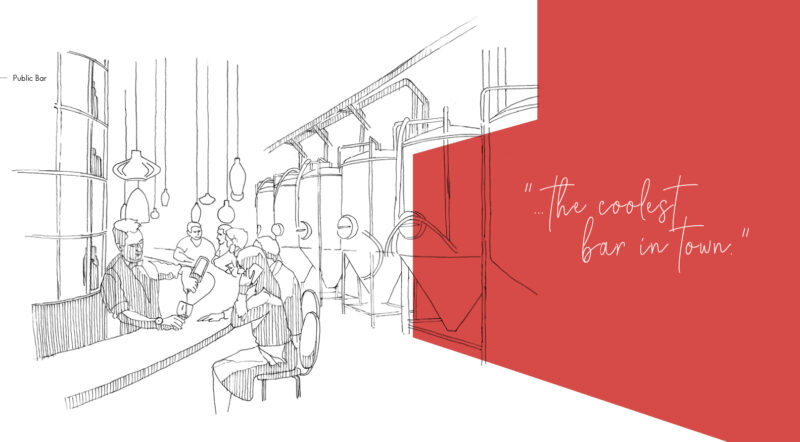What can we learn from successful hotels?
Strong brands already use captivating narratives as part of their retail strategies. And yet all sectors need to identify and implement new customer experience standards.
Inspiration comes not least from new hospitality concepts, which set trends in terms of their design, technology, and service. We sent two aficionados to find out more, discuss their impressions, and sketch out their ideas. The results are as feisty as they are valuable: 10 theses on hospitable architecture and the customer journeys of the future.

Raphael Gielgen (Interior designer and trend scout)
As an interior designer, “new work” trend scout for Vitra, and professional hotel guest, Raphael Gielgen is on the road 180 days a year. He investigates the impact physical locations have on public space and society, with interests ranging from hotels and restaurants, offices and co-working spaces, to the hippest retail sites.
Lisa Hassanzadeh (Head of Interior, concrete Amsterdam)
Interior designer Lisa Hassanzadeh is in no doubt: Hospitality in particular must always be willing to ask what can be done differently and better. With concrete, her Amsterdam-based architecture office, she initiated the citizenM design hotel chain. Alongside lifestyle brand hotels, she focuses on designing residential, office, retail, and gastronomy concepts.

1. HOSPITALITY MEETS YOU ON THE WAY.
LH The customer journey begins in people’s minds, when they visit the booking website. It continues when they are on their way: I want to be there before I get there. Soon, transport will be more communal, autonomous, and comfortable. We will have the inner calm to prepare for our destination. The best thing is if the hotel already meets me on the way. It could welcome me, for example, with an electronic edition of the local daily newspaper before I arrive. Digital harbors great potential here.
RG We need to repeat the question: Where does hospitality actually begin? In the lobby? At the reception desk? For me, the hotel has to be a hotel long before it takes physical shape.
2. RECEPTION THRIVES ON RITUALS.
LH Reception should not mean being confronted by a line at the front desk and then filling in papers with someone behind a screen. That is why we introduced digital check-in for citizenM back then.
There is great longing for human contact in the digitalized world. Raphael Gielgen
RG Automation comes with the risk that we overlook or no longer cultivate specific practices. These are actually rituals. The travel experience begins when you arrive in exciting new surroundings and your host asks you in the local accent if you already know the hotel. Somebody to show you round and say: “Nice to have you with us!” That is the secret behind Airbnb’s success, because people were tired of sleeping in anonymous houses. There is great longing for human contact in the digitalized world.
LH It goes without saying that digital technologies should be used to remove all bureaucratic barriers between guests and hosts. And that gives hotel staff time for the rituals. The difference is that I can now decide myself how much contact and assistance I need. It is about being able to control how I spend my time.
3. HOTELS RESPOND TO YOUR TIME SCHEDULE.
LH Hotels have to fit a specific approach to life. You should never build anything to please everyone. But people’s behavior varies even within clear target groups. Sometimes I use a hotel as a “sleep capsule” for one night, while at other times I spend my vacation there. It depends on the time schedule. Either way, it is still my hotel.
RG When I am in transit, I really just need a kind of express menu for overnight stays. Can the architecture be strong enough to really provide solutions for both sets of needs?
LH You’re right. You can minimalize everything right down to a capsule hotel. But they are only good for airports or railroad stations. Even if you only want to shower and use the WiFi, you are still pleased when you walk through attractive spaces and see people who tick differently in the lobby. You’re delighted if your hotel room, even if it is only ten square meters, grabs your attention with its characteristic design and services.
4. YOUR ROOM HAS FLIGHT MODE.
LH Guests at inner-city hotels are often business travelers with tight schedules. They have little time free and spend nearly all of it at the hotel. To make the best of that, the place where they eat and sleep is actually very important.
RG For me, the ideal room is very high up with a view out over the city. Definitely not the backyard. I need a bathroom that is not sealed off, but fits into the overall room, and a desk with a view out of the window. And all the sockets for my electronic devices should be ready to use.
LH In future, all hotel rooms should also have an “off” button to switch off all digital applications. A kind of flight mode or sleep mode. I doubt that networking is a basic need. Offline is the new luxury.
5. EXPLORERS HAVE NO REASON TO GO OUT.
RG I like it when the restaurant, bar, and lobby are all on the same floor and you are free to wander through rooms that offer variety. I sit down at a large table with other guests or withdraw to a corner. Either way, I need good visual axes and topography – a sense there is something to explore.
LH We always try to build hotels that are strongly integrated into their surroundings. If you do not leave the building for three days, you should always feel what city and what country you are in, even without looking outdoors. In terms of the construction, you can separate that of course. The rooms are modular standard, while the public areas are designed with the individual context clearly in mind. But before you select any furniture, you have to decide: What are the key characteristics of this environment?

6. THE CITY COMES TO YOU.

RG The geographical location with its surrounding ecosystem is an ever more important factor in determining what customers are willing to pay for. They want to get to know and experience a specific niche of the city. If we want public space, we have to do public design that enables guests to take part in city life.
LH Some hoteliers are starting to see that this is worth investing in. And we are already making consistent progress with some of them. Everything on offer in their hotels – from beer to soap – comes directly from their part of the city. We also ask: Why would a guest wish to leave the hotel? We then make sure we offer precisely those things in the hotel. That may even involve operating the coolest bar in town. This way, the city comes to the hotel, rather than the other way round.
7. THE HOTEL IS A VILLAGE.
RG Five years from now, there will be no major development planning that does not include co-creation with the neighborhood. If we take Neue Mitte Bremen, Hammerbrooklyn in Hamburg, or the City of Toronto, which is building this way with Google, we can see that this principle is already gaining ground. Rather than more exclusive, hotels are becoming more inclusive.
LH The neighborhood can actually take shape around the hospitality location, which offers a center that was not there before, with a bar, café, swimming pool, cleaning services, and shared gardens. In suburban areas we have already implemented this mix of residential complexes and hotels. That actually means building a village with publicly shared amenities. A microcosmos in its own right.
RG That really is public space. Everyone enjoys the benefits of the location. And if I can also get anywhere else from there, then that is a good option even for very mobile travelers. Can we map this approach onto inner-city districts as well?
LH That is already happening at Zoku in Amsterdam. In more densely populated cities such as New York, the village would probably be vertical. We are also dismantling boundaries in terms of the length of stay. You can book a studio for a night or a whole year. The longer you stay, the more you benefit from “village life”, with everything from cookery courses to urban gardening.
8. THE POOL BECOMES THE OFFICE.
RG To stay viable, hospitality locations should experiment more to see which other sectors they can integrate and connect.
LH Co-working is already being promoted in many lobbies.
RG Hotels can make much more targeted use of their infrastructure – their lobbies, lounges, cafes, and bars. In a new building in an interesting district, you can plan a floor for creative co-working spaces. This approach boosts the vitality of an inner-city hotel and also makes it more attractive for overnight guests. You see – there’s lots going on! And daytime guests can use the spa and gym in the evening without changing location. Or why not just work next to the pool?
LH Concept stores are also set to play a greater role. Just imagine the hotel as a one-stop shop where you can discover and dip into the lifestyle of the city.
9. GRETA DECIDES WHAT LUXURY IS.
LH These days, we are all a bit weary of globalization and consumption. Diversity will be the luxury of the future. We do not need everything to be available everywhere. Instead, consistent local thinking can release fresh creativity. I work with a head cook in Baltimore who only uses ingredients from within 100 miles of his restaurant. He even does without olive oil. His food tastes of its surroundings, which is what makes it special. That turns it into a luxury experience.
Diversity will be the luxury of the future. Lisa Hassanzadeh
RG There are the UN sustainability goals – water, food, work safety, etc. Every major hotel chain has already embraced these topics – or should do so. By 2030, that will be the quality seal and the norm. Maximum localization in the way you outlined will then be the gold standard.
10. SUCCESSFUL HOTELS SHARE A (HI)STORY.
RG A hotel has to provide people with a sense of belonging. It attracts people who share similar values and offers them a home, a community. That already worked in the old days. The grand hotels of the Belle Époque were social and cultural venues – the ancestors of today’s shared spaces. Since then, the sector has been trimmed for experience-driven tourism. But we can create these venues anew. Like in retail and other sectors, what it needs is a strong narrative. A story which connects customers with the owner’s mindset. One they can feel, see, and hear around them. That is not a question of money.